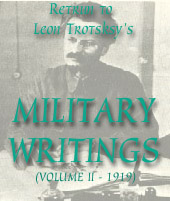
For the fight against Mamontov’s cavalry we have put out a call to daredevil guerrilla fighters. There may be some who will say to themselves in bewilderment: ‘How is this? The Soviet military authorities have always condemned guerrillas and opposed the use of guerrilla methods, and yet now they themselves are encouraging guerrillas again!’
This way of seeing the problem would signify a complete misunderstanding, due to the circumstance that quite different things are meant by one and the same word ‘guerrilla-ism’. The Ukrainian guerrillas, who proved incapable of defending the Soviet Ukraine, consisted of hastily assembled detachments made up of untrained and poorly-armed worker and peasant rebels. A properly constructed, regular army had not yet been formed in the Ukraine.
Our Red Army grew entirely out of volunteers, rebels, primitive, inexperienced guerrillas. Through protracted struggle we overcame this amorphous, clumsy guerrilla-ism and built proper, trained, disciplined regiments and divisions. But just now, when we have a stronger regular army, we can and must supplement it with well-organised guerrilla detachments. An army acts as a solid mass, sweeping away the enemy who has occupied an extensive territory. Guerrilla detachments, while subject to the same command, separate themselves, when necessary, from the main army, in order to carry out particular tasks, causing damage to the enemy and making their way deeply into his rear. [62]
The guerrillas we need, of course, are not those of the Mahkno type. We did not need helpless, timid bands of scarcely armed men, but very well organised, trained, seasoned, bold light detachments, equipped with all that they need, and carrying out tasks assigned to them by the overall command.
Depending on their tasks, guerrilla detachments may be of various sizes, ranging from a group of ten or twenty daredevils to a cavalry force comprising several thousand sabres, with light artillery and armoured cars.
Mamontov’s raid has now created an acute need for guerrilla detachments. Mamontov is himself undoubtedly a guerrilla.
He has separated himself by hundreds of versts from Denikin’s forces, and is roaming about in the rear of our armies, destroying railway lines. We cannot deny that Mamontov’s detachment possesses adroitness and mobility. True, it is doing brigands’ work, killing unarmed workers and peasants, raping and so on. But that is the fate of a counter-revolutionary guerrilla movement, which serves the dirty aims of the landlords and capitalists. We have to make our guerrillas serve the lofty tasks of the working people.
Slow-moving infantry will not keep pace with Mamontov’s cavalry. Here we need light detachments mounted on horse back, in carts, in motor-cars and boats, but also on foot as well, acting unexpectedly from ambush, or stealing up by night and taking the enemy unawares. For detachments like these we need the best fighters, the most self-sacrificing and most disciplined, for, unlike the unruly Makhnovites, real guerrillas require an iron discipline that is stricter even than in the regular regiments.
Mamontov’s raid forces us to take a step forward in the building of our army. If we were able to go over from insurgency and amorphous detachments to a regular, centralised army, we shall be able in just the same way to supplement and strengthen this centralised army with splendid guerrilla detachments, moulded from steel, which will thrust them selves like sharp thorns into the enemy’s body.
To the question about whether we need guerrillas we must answer: yes, we do need guerrillas, they are necessary for our purpose – but only real guerrillas, really brave men, warriors without fear and without reproach, for whom nothing is impossible. In the last period of the civil war, detachments of such daredevils can, if backed by the weighty masses of the Red Army, play a very great role, paving the way for the army, speeding up its attack, covering its flanks, threatening the enemy’s rear, raising revolts in that rear, appearing here, there and everywhere as the embodiment of the spirit of the revolution.
This kind of guerrilla movement we must now create.
September 6, 1919
Orel
En Route, No.88
62. Guerrilla war means independent operations by forces detached from the army, cut off, if only for a time, from communication with it, and engaged in inflicting damage on the enemy, mostly in his rear. Vulnerability of the enemy’s rear creates the most favourable conditions for the development of guerrilla operations (compare the operation by guerrilla detachments in Napoleon’s rear in 1812). The purpose of the operations of such detachments is in the main to sever or obstruct the enemy army’s communications with its sources of food and of reinforcements, and also to destroy these sources. Another very important task of guerrilla detachments is to organise forces in the enemy’s rear, carry on propaganda, and create cells for providing intelligence.

Last updated on: 22.12.2006